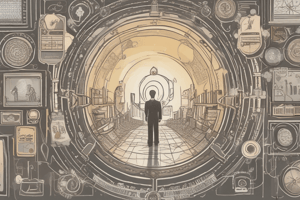Podcast
Questions and Answers
What is organizational culture, and what does it define for employees?
What is organizational culture, and what does it define for employees?
Organizational culture is a system of shared assumptions, values, and beliefs that defines what is appropriate and inappropriate behavior for employees.
What is the limitation of assuming a single culture throughout an organization?
What is the limitation of assuming a single culture throughout an organization?
It is an oversimplification, as there may be multiple cultures within an organization, such as subcultures emerging in different departments, branches, or geographic locations.
What is a subculture, and how does it emerge within an organization?
What is a subculture, and how does it emerge within an organization?
A subculture is a culture that emerges within different departments, branches, or geographic locations, arising from personal characteristics, work conditions, and departmental goals.
What are the differences in subcultures that may emerge between departments?
What are the differences in subcultures that may emerge between departments?
What is an example of subcultures within a single organization?
What is an example of subcultures within a single organization?
Why is it important to recognize and understand subcultures within an organization?
Why is it important to recognize and understand subcultures within an organization?
How can an organization's culture be uncovered?
How can an organization's culture be uncovered?
What is the role of organizational culture in achieving a competitive advantage?
What is the role of organizational culture in achieving a competitive advantage?
How can an organization's culture impact its performance?
How can an organization's culture impact its performance?
What is the relationship between organizational culture and employee behavior?
What is the relationship between organizational culture and employee behavior?
Why is it important to manage conflict in the workplace?
Why is it important to manage conflict in the workplace?
What is the role of organizational culture in conflict management?
What is the role of organizational culture in conflict management?
What is the definition of conflict management?
What is the definition of conflict management?
What are the common conflict management styles?
What are the common conflict management styles?
Why is it important to have a culture of respect, civility, and inclusion in the workplace?
Why is it important to have a culture of respect, civility, and inclusion in the workplace?
What is the ultimate goal of conflict management in an organization?
What is the ultimate goal of conflict management in an organization?
What are the two types of subcultures mentioned in the text, and how do they differ?
What are the two types of subcultures mentioned in the text, and how do they differ?
What is the relationship between employee perceptions of subcultures and their commitment to the organization?
What is the relationship between employee perceptions of subcultures and their commitment to the organization?
What is a counterculture, and how does it relate to the broader organizational culture?
What is a counterculture, and how does it relate to the broader organizational culture?
What are the three interrelated levels of organizational culture, according to Schein?
What are the three interrelated levels of organizational culture, according to Schein?
What is the deepest level of organizational culture, and what does it reflect?
What is the deepest level of organizational culture, and what does it reflect?
What is the difference between values and artifacts in organizational culture?
What is the difference between values and artifacts in organizational culture?
Why is it important for individuals to understand the organization's culture, including its basic assumptions and values?
Why is it important for individuals to understand the organization's culture, including its basic assumptions and values?
How can observing an organization's artifacts help in understanding its culture?
How can observing an organization's artifacts help in understanding its culture?
What is the limitation of simply observing an organization's artifacts in understanding its culture?
What is the limitation of simply observing an organization's artifacts in understanding its culture?
What is the significance of understanding subcultures in an organization, especially for managers and employees?
What is the significance of understanding subcultures in an organization, especially for managers and employees?
When is the collaborating conflict management style typically used?
When is the collaborating conflict management style typically used?
What are the potential risks of using the competing conflict management style?
What are the potential risks of using the competing conflict management style?
In what situations might the avoiding conflict management style be effective?
In what situations might the avoiding conflict management style be effective?
When is the accommodating conflict management style typically used?
When is the accommodating conflict management style typically used?
What are the key elements of effective communication in resolving conflicts in organizational culture?
What are the key elements of effective communication in resolving conflicts in organizational culture?
What is the potential drawback of using the compromising conflict management style excessively?
What is the potential drawback of using the compromising conflict management style excessively?
How can conflicts arising from power and authority be addressed in an organization?
How can conflicts arising from power and authority be addressed in an organization?
What is one of the most common sources of conflict in organizational culture?
What is one of the most common sources of conflict in organizational culture?
What can lead to misunderstandings, stereotypes, discrimination, and resentment among employees in an organization?
What can lead to misunderstandings, stereotypes, discrimination, and resentment among employees in an organization?
What is the role of values and goals in avoiding conflicts in organizational culture?
What is the role of values and goals in avoiding conflicts in organizational culture?
How can organizations manage and resolve conflicts arising from change and innovation?
How can organizations manage and resolve conflicts arising from change and innovation?
What is another common source of conflict in organizational culture?
What is another common source of conflict in organizational culture?
What are the consequences of not addressing conflicts arising from power and authority in an organization?
What are the consequences of not addressing conflicts arising from power and authority in an organization?
What can cause conflicts related to communication styles in an organization?
What can cause conflicts related to communication styles in an organization?
What is the importance of adapting communication style to suit the situation, audience, and purpose in resolving conflicts in organizational culture?
What is the importance of adapting communication style to suit the situation, audience, and purpose in resolving conflicts in organizational culture?
What is necessary to prevent and resolve conflicts related to diversity and inclusion in an organization?
What is necessary to prevent and resolve conflicts related to diversity and inclusion in an organization?
Flashcards are hidden until you start studying
Study Notes
Organizational Culture
- Organizational culture refers to a system of shared assumptions, values, and beliefs that show employees what is appropriate and inappropriate behavior.
- It is a system of shared values, assumptions, and beliefs that shape the organization's culture.
Levels of Organizational Culture
- Three interrelated levels:
- Basic assumptions (deepest level, below our awareness, reflect beliefs about human nature and reality)
- Values (shared principles, standards, and goals)
- Artifacts (visible, tangible aspects of organizational culture, e.g., physical environment, employee interactions, company policies)
Subcultures
- A culture that emerges within different departments, branches, or geographic locations within an organization
- May arise from personal characteristics of employees and managers, as well as different conditions under which work is performed
- Examples: sales floor vs. warehouse, marketing vs. manufacturing departments
Importance of Organizational Culture
- Can be a competitive advantage or a liability
- Can affect employee behavior and performance
- Shapes how employees respond to conflict and change
Conflict Management
- The practice of identifying and managing conflicts sensibly, fairly, and efficiently
- Conflict management styles:
- Collaborating (produces best long-term results, but can be time-consuming)
- Competing (rejects compromise, prioritizes one's own needs)
- Avoiding (ignores or evades conflict)
- Accommodating (puts the needs of the other party first)
- Compromising (seeks a middle ground)
Sources of Conflict in Organizational Culture
- Diversity and inclusion
- Communication styles
- Power and authority
- Values and goals
- Change and innovation
Resolving Conflicts
- Foster a culture of respect, empathy, and openness to manage diversity and inclusion conflicts
- Adapt communication styles to suit the situation, audience, and purpose
- Establish clear rules, policies, and procedures to manage power and authority conflicts
- Align values and goals with the organization's vision and mission
- Create a culture of learning, curiosity, and adaptability to manage change and innovation conflicts
Studying That Suits You
Use AI to generate personalized quizzes and flashcards to suit your learning preferences.



